Click on images to enlarge
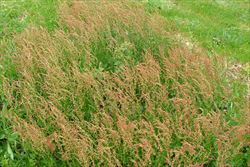
dense infestation, developing from a single large clump-forming colony (Photo: Sheldon Navie)
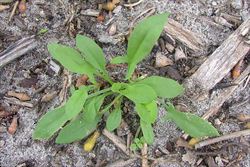
young plant forming a loose basal rosette of leaves (Photo: Sheldon Navie)
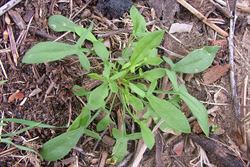
older plant with more obviously lobed leaves (Photo: Sheldon Navie)
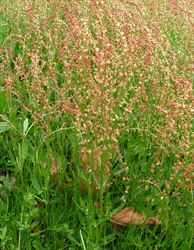
habit in flower (Photo: Sheldon Navie)
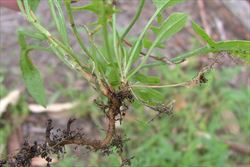
leaf undersides and creeping underground stems (Photo: Sheldon Navie)
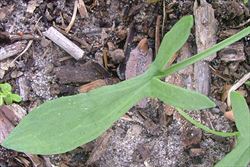
close-up of the arrowhead-shaped leaf with two basal lobes (Photo: Sheldon Navie)
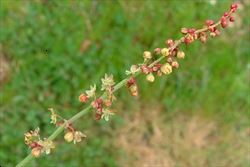
male flowers, borne in groups of 5-8 along the branches of the flower clusters (Photo: Sheldon Navie)
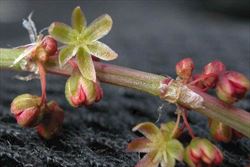
close-up of male flowers (Photo: Greg Jordan)
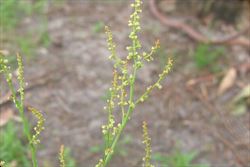
branched female flower clusters (Photo: Sheldon Navie)
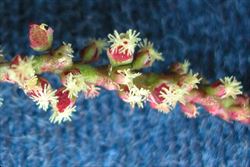
close-up of female flowers with feathery stigmas (Photo: Greg Jordan)
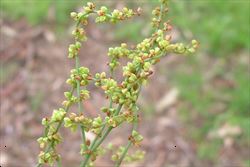
close-up of immature fruit (Photo: Sheldon Navie)
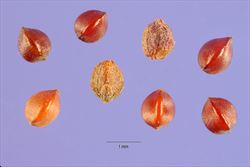
close-up of seeds (Photo: Steve Hurst at USDA PLANTS Database)
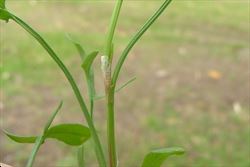
finely grooved stems and leaf stalks, with a see-through 'sheath' at the base (Photo: Sheldon Navie)
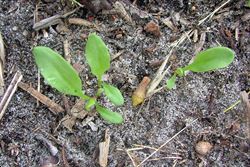
'seedlings', or more accurately young shoots emerging from the creeping underground stems (Photo: Sheldon Navie)
Scientific Name
Acetosella vulgaris Fourr.
Synonyms
Acetosa angiocarpa (Murb.) Á. Löve (misapplied)
Acetosella vulgaris Fourr. subsp. pyrenaica (Pourr. ex Lapeyr.) Á. Löve
Rumex acetosella L.
Rumex acetosella L. subsp. acetosella
Rumex acetosella L. subsp. pyrenaica (Pourr. ex Lapeyr.) Akeroyd
Rumex acetosella L. var. vulgaris Koch
Rumex angiocarpus Murb. (misapplied)
Rumex pyrenaica Pourr. ex Lapeyr.
Family
Polygonaceae
Common Names
common sheep sorrel, cow sorrel, field sorrel, horse sorrel, red sorrel, sheep sorrel, sheep's sorrel, sorrel, sour-grass, sour-weed
Origin
Native to western and central Europe (i.e. Denmark, Ireland, Norway, Sweden, the UK, Austria, Belgium, Czechoslovakia, Germany, Switzerland, Italy, Yugoslavia, France and Spain).
Cultivation
Occasionally cultivated as a culinary herb or vegetable, but mostly seen as a weed of gardens.
Naturalised Distribution
This species is very widely naturalised in southern and eastern Australia. It is most common in south-eastern Queensland, eastern New South Wales, the ACT, Victoria, Tasmania, south-eastern South Australia and south-western Western Australia. Also occasionally naturalised in the coastal districts of central and northern Queensland, and in other parts of New South Wales and South Australia.
Habitat
Sheep sorrel (Acetosella vulgaris) is a weed of crops, pastures, gardens, footpaths, roadsides, coastal areas, wetlands, heathlands, grasslands, open woodlands and alpine areas. It is most common in the temperate regions of Australia, but is also present in sub-tropical areas.
Habit
A long-lived (i.e. perennial) herbaceous plant with creeping underground stems (i.e. rhizomes) and upright (i.e. erect) branched flowering stems 10-60 cm tall.
Distinguishing Features
- a small clump-forming herbaceous plant with an extensive underground root system.
- its stalked leaves are distinctively arrowhead-shaped, with two basal lobes.
- its tiny green or reddish flowers are borne in branched clusters at the top of upright flowering stems.
- separate male and female flowers are borne on separate plants.
- its tiny fruit (1-1.5 mm long) are three-sided and remain hidden inside the remains of the flowers.
Seedling
The two seed-leaves (i.e. cotyledons) are elongated or oval in shape (i.e. narrowly-elliptic) with rounded tips (i.e. obtuse apices). They ar hairless (i.e. glabrous) with tapering bases and short stalks (i.e. petioles). The first true leaves have longer stalks (i.e. petioles) and are broader, being either oval or egg-shaped in outline (i.e. elliptic or ovate). They are also hairless (i.e. glabrous) and have somewhat pointed tips (i.e. acute apices). Late leaves are progressively more triangular in shape, with pointed lobes at their bases.
Stems and Leaves
This slender, clump-forming, herb develops an extensive network of branching underground stems (i.e. rhizomes), off which numerous aboveground shoots atre produced each year. Plants initially form loose, few-leaved, rosettes and then eventually develop upright (i.e. erect) flowering stems. These flowering stems are slender, green, hairless (i.e. glabrous), and have tiny grooves running lengthwise.
The alternately arranged leaves are borne on stalks (i.e. petioles) ranging from 0.5-7 cm long. These leaves (1-8 cm long and 0.5-3 cm wide) are somewhat elongated and shaped like arrowheads (i.e. hastate) with undulating, but otherwise entire margins. The two lobes at the base of the leaves vary in size and shape depending on the leaves position on the plant, but are usually about 15-25 mm long. The leaves are hairless (i.e. glabrous) with pointed tips (i.e. acute apices). The base of each leaf stalk (i.e. petiole) also has dilated margins that form a see-through membranous sheath called an 'ochrea' which usually encloses part of the stem.
Flowers and Fruit
The flowers are small, green or more commonly reddish in colour, and arranged in upright (i.e. erect) branched clusters at the tips of the stems (i.e. in terminal panicles). Separate male and female flowers are borne on separate plants (i.e. this species is dioecious). Flowers are borne in small groups (i.e. whorls) of 5-8 along the flowering branches. They are about 1-2 mm long and are borne on short stalks (i.e. pedicels) up to 2 mm long. Each flower has three tiny 'sepals' and three 'petals' (i.e. inner and outer perianth segments). Male flowers also have six yellow stamens, while female flowers have an ovary topped with a three-branched stye and feathery (i.e. fimbriate) stigmas. Flowers occurs mainly during spring and early summer (i.e. from September to December).
The tiny fruit is a three-sided nut 1-1.5 mm long. These fruit are smooth and shiny, remain hidden inside the remains of the flowers parts, and turn brown as they mature.
Reproduction and Dispersal
This species reproduces by seed and vegetatively via its creeping underground stems (i.e. rhizomes).
Thes seeds maybe spread by wind, water and animals that eat the seeds. They may also be dispersed in mud adhering to animals and vehicles, in soil, and in contaminated agricultural produce (e.g. fodder, pasture seed and grain). Seeds and rhizomes can also be spread in dumped garden waste, in nursery pots, and during cultivation.
Environmental Impact
Sorrel (Acetosella vulgaris) is regarded as an important environmental weed in south-eastern Australia, particularly in Victoria and New South Wales. While this species is also known as a weed of crops and pastures, it invades a wide variety of natural habitats (e.g. dry coastal vegetation, heathlands, heathy woodlands, grasslands, grassy woodlands, dry sclerophyll forests, wetlands, rocky outcrops, and sub-alpine and alpine vegetation).
It is of most concern in the sub-alpine and alpine regions of south-eastern Australia, where it can form dense carpets, and is thought to be the most common weed species in the treeless vegetation of the Australian Alps. Sorrel (Acetosella vulgaris) is particularly troublesome in the Kosciuszko alpine area in the southern tablelands region of New South Wales, where it is the most widespread non-native colonising species. It primarily invades bare areas and disturbed sites, but can eventually be replaced by native species is soem situations.
Sorrel (Acetosella vulgaris) is considered to pose a threat to the integrity of one or more vegetation formations in Victoria. It is a common weed of buloke grassy woodlands, riparian shrublands and montane riparian woodlands in this state, and has been recorded in numerous conservation areas (e.g. Organ Pipes National Park, Morwell National Park, Yarra Bend Park, Boonderoo Nature Conservation Reserve, Dreeite Nature Conservation Reserve, Pomborneit North Nature Conservation Reserve, Rice Nature Reserve, Dans Nature Reserve and Phillip Island Nature Park). It is also a commonly reported weed species in vegetation supporting almost all of the remaining known populations of the vulnerable Euroa guinea-flower (Hibbertia humifusa subsp. erigens). This spcies is endemic to north-eastern Victoria, and weed invasion by sorrel (Acetosella vulgaris), and other weed species, is considered to be the greatest threat to almost all populations of this native plant.
Sorrel (Acetosella vulgaris) is also a principal weed species in tableland basalt forests in the Sydney Basin and South Eastern Highlands bioregions of New South Wales. This vegetation type is listed as an endangered ecological community by the NSW Scientific Committee, and is being threatened by weed invasion. Sorrel (Acetosella vulgaris) has also been recorded in conservation areas in New South Wales (e.g. Kosciuszko National Park, Cecil Hoskins Nature Reserve and Kuma Nature Reserve) and South Australia (e.g. Montacute Conservation Park, Moana Sands Conservation Park, Totness Recreation Park and Cudlee Creek Conservation Park), and is a weed of disturbed wetlands, woodlands, creeks and granite slopes from Moora to Esperance in south-western Western Australia.
Other Impacts
Sorrel (Acetosella vulgaris) leaves contain oxalates and can poison livestock, especially sheep. However, it is generally not grazed by livestock and may become locally dominant in temperate pastures, thus reducing the grazing capacity and productivity of infested areas. It is also a common weed of crops in the temperate regions of Australia.
Legislation
Not declared or considered noxious by any state or territory government in Australia.
Similar Species
Sorrel (Acetosella vulgaris) is similar to some of the docks (Rumex spp.), including rambling dock (Acetosa sagittata) and rosy dock (Acetosa vesicaria). However, it can generally be distinguished from other docks by the fact that its tiny fruit have no obvious projections (i.e. they lack wings or teeth). The clumping habit of this species and its separate male and female flowers on separate plants are other distinguishing features.

